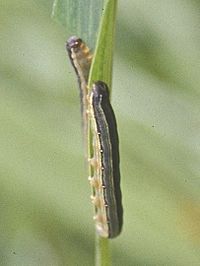
Photo from wikipedia
The insect gut has been the house of many taxonomically and physiologically diverse groups of microbial colonizers as symbionts and commensals, which are evolving to support the physiological requirement of… Click to show full abstract
The insect gut has been the house of many taxonomically and physiologically diverse groups of microbial colonizers as symbionts and commensals, which are evolving to support the physiological requirement of insects. Lepidoptera is one of the important family of class hexapoda, comprising agriculture insect pest Spodoptera litura and Spilosoma obliqua. Information on gut microbiota and their functional role in these insects was meager to elucidate the wide‐ranging survivalist mechanisms. In this context, we analyzed the composition, diversity and functional role of gut bacteria in S. litura and S. obliqua collected from soybean and sunflower crops, respectively, using Next Generation Sequencing of 16S rRNA. A total of 3427 and 206 Operation Taxonomic Units (OTUs) were identified in S. litura and S. obliqua gut metagenome, respectively. Highest number of sequences were annotated to unclassified bacteria (34%), followed by Proteobacteria (27%), and Chlorobi (14%) in S. litura, while S. obliqua has significant representation of Firmicutes (48%), followed by Bacteroidetes (20%), and unclassified bacteria (11%). Functionality of both metagenomes revealed, high abundance of ammonia oxidizers (20.1 58.0%) followed by relative abundance of detoxifying processes – dehalogenation (17.4–41.2%) and aromatic hydrocarbons degradation (1.1–3.1%). This study highlights the significance of the inherent microbiome of two defoliators in shaping the metagenome for nutrition and detoxifying the chemical molecules, and opens an avenue for exploring role of insect gut bacteria in host selection, metabolic endurance of insecticides and synergistic or agonistic mechanisms inside gut of insects feeding on insect‐resistant biotech crops.
Journal Title: Journal of Basic Microbiology
Year Published: 2018
Link to full text (if available)
Share on Social Media: Sign Up to like & get
recommendations!